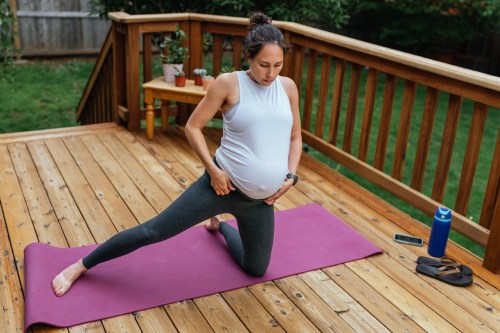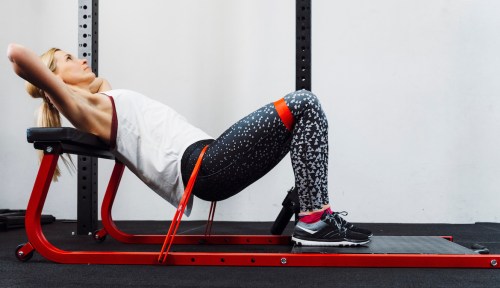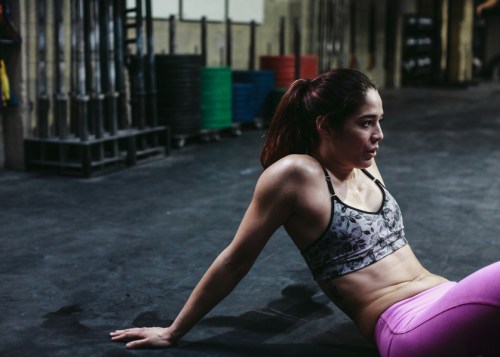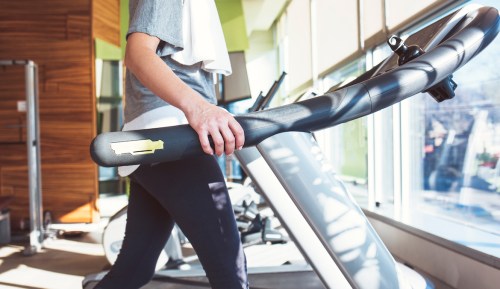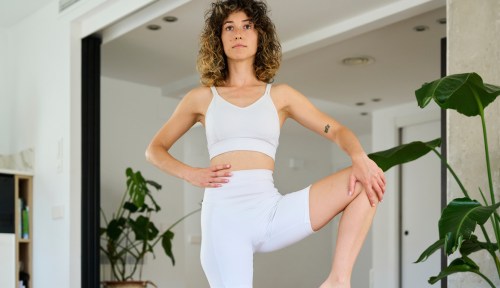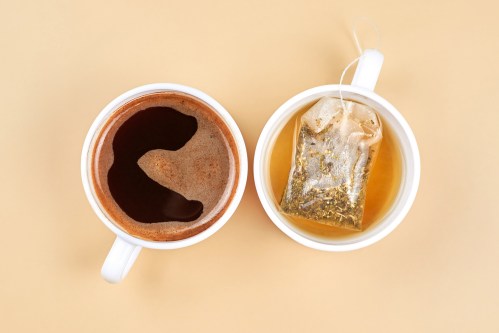I’m playing with my baby on the floor and all of a sudden he’s decided he’s hungry. The challenge: Get the two of us from the rug to the nursing chair before my son’s whimper turns into a full blown howl. Also, bring my phone along so I can track my feeding session.
Experts in This Article
health coach and certified personal trainer
Holding my baby and my phone leaves exactly zero hands to help with hoisting myself off the floor, but it’s okay. Without thinking about it, I put my legs in a straddle position, then bend one leg in front of me and one leg behind me into a 90-90 stretch. Next, I take a deep inhale and as I exhale, engage my core and lift myself up into kneeling from that 90-90 stretch. From there, it’s easy to transition into basically a lunge, and up to standing. Ta-da!
Sound complicated? When I first learned this move, called the “ground get up,” figuring out where to place my limbs and in what order confounded me. I was also pregnant, so my brain was already fuzzy, and I had the built in extra resistance challenge of my baby bump.
But practicing it over and over again as my belly grew bigger and bigger helped me gain both strength and muscle memory. By the time my son came along, I realized I was doing ground get ups when I needed them without even thinking about it.
The ability to subconsciously apply something from my prenatal training into my postnatal life made me excitedly text my trainer and friend who taught it to me, health coach and certified personal trainer Azul Corajoria, CPT. She said she was proud “but not surprised,” because the move is what she calls an “active daily living” exercise, which is a kind of functional fitness she wanted to teach me so I could use it in my everyday life.
“[Ground get ups] are a functional strength-training movement that teaches you how to get up and down from the ground in a safe way,” Corajoria says. “You want to get active daily living exercises so ingrained that by the time that you’re a [parent] and you’re thinking about a million different things, this is one less thing that you have to think about.”
How to do a ground get up

- 1.Sit on the ground and bring your legs out wide in a “V” straddle position.
- 2.Shift your legs so that one is out more in front of you, and one is pointing more out to the side.
- 3.Bend each of your knees so your feet are pointing out in the same direction, each lower leg making a 90-degree angle with the upper leg at the knee. This is called a 90-90 pose. Your front shin/calf should be just about parallel to your back quad.
- 4.Take a big inhale.
- 5.Keeping your calves/shins where they are, engage your core as you breathe out so that you rise up to a kneeling position.
- 6.Bring your back leg around to the front so that you are in a half-kneeling lunge.
- 7.Engage your hamstrings and quads as you lift up into standing.
“[Ground get ups] are a functional strength-training movement that teaches you how to get up and down from the ground in a safe way.” —Azul Corajoria, CPT
The benefits of ground get ups
Getting off the ground while carrying around the extra load of my belly was a useful skill to learn itself, but it also helped strengthen my core and stabilizer muscles without putting pressure on my abdomen, which is also important for building strength and stability and reducing pain during pregnancy. But Corajoria says those skills can apply to many more people beyond those carrying babies (in their bellies or in their arms).
“You’d be surprised how many people can’t get off the floor without using their hands due to overall lack of strength or mobility, which is really common if you haven’t lifted weights ever and is really common if you have stiff joints,” Corajoria says. “It’s a fundamental skill that most people should be able to do, and [the ground get up] is a great functional assessment of how mobile and strong you are.”
What makes the move so “fundamental” is how comprehensive it is as a compound movement.
“It works your core, it works the muscles that run down your spine, it works your hip flexors, it works your glutes, it works your legs when you come up from the reverse lunge—so almost all of the muscles in your body,” Corajoria says. “And because you’re also working on balance and coordination, it’s working all the little stabilizer muscles as well, in conjunction with the larger muscles.”
Not to mention, if you’re carrying something in your arms—like a dumbbell, or, say, a baby—it’ll work your arms, back, and shoulders, too. And that’s just the strength component. You’ll also need to engage your balance and coordination skills. The move requires mobility in your hips, knees, and ankles, and flexibility in your hamstrings, quads, and glutes. Finally, tying it all together is the breath.
“Breathing out as you’re coming up is really important,” Corajoria says. “When you’re coming from sitting to standing, making sure you’re breathing out is teaching you proper spinal alignment. The idea is that you don’t use your hands and that you don’t round down, so you’re keeping your shoulders back and you’re sitting upright, which is strengthening your back but it’s also teaching you how to maintain that proper posture so you don’t get lower back pain later on down the line, or you don’t pull something when you’re trying to get up with your baby in your arms.”
It’s a lot to keep in mind, but the mental challenge of coordination is part of what makes it great for older populations, too. Corajoria says ground get ups build “neuromuscular function,” which is essentially your brain’s ability to tell your muscles what to do and have your muscles execute those instructions. Neuromuscular function can decline1 as you get older, so practicing coordination-based moves is important to keep that skill sharp—and to build in some more muscle memory for essential skills like getting up from the floor.
“You always want to build the foundation when you don’t need it most,” Corajoria says. “That way by the time you do need it, you don’t really have to think about it.”
Essentially, the ground get up is a move for everybody, no matter what stage of life you’re in, because it sets you up for lifelong strength and safety.
How to work up to a ground get up
Because ground get ups require strength, coordination, flexibility, and mobility, putting it all together at once might not be the best starting point for you. Luckily, it’s a compound movement, so you can break it up into its component parts.
“It’s quite literally a couple different exercises in one, which is what makes the mental load of it kind of difficult,” Corajoria says. “But you can always break it down into different pieces.”
Sitting on the ground in a straddle might not be feasible for you. Practice straddling from an elevated surface, such as sitting on the edge of a sofa. Once that feels comfortable, try straddling on the ground. Finally progress to the the 90-90 stretch. And you can also incorporate some ankle circles separately. To build strength and balance, Corajoria suggests practicing reverse lunges and squats. Runner’s lunges should help with hip mobility, too.
How to progress the ground get up
By my third trimester, I had my own form of resistance training built in to ground get ups. But you can progress the move by holding a weight in front of you, or on just one side for an added stability challenge. Consider trying the Turkish get up if you want to test your coordination and strength even further.
Morrison S, Newell KM. Aging, neuromuscular decline, and the change in physiological and behavioral complexity of upper-limb movement dynamics. J Aging Res. 2012;2012:891218. doi: 10.1155/2012/891218. Epub 2012 Aug 1. PMID: 22900179; PMCID: PMC3415207.
↩︎
Sign Up for Our Daily Newsletter
Get all the latest in wellness, trends, food, fitness, beauty, and more delivered right to your inbox.
Got it, you've been added to our email list.
